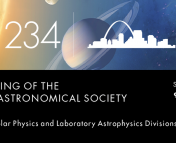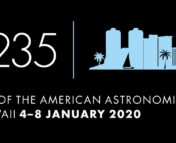In this series of posts, we sit down with a few of the keynote speakers of the 240th AAS meeting to learn more about them and their research. You can see a full schedule of their talks here, and read our other interviews here!

Today, we interviewed a very exciting AAS 240 keynote speaker, a former Astrobiter, Dr. Allison Strom! Dr. Strom has just recently shared amazing news with the Twitter population – she is going to be a Professor at Northwestern University! We’re very delighted to see former Astrobiters thrive in their research and their lives. So, let’s dive in into Dr. Strom’s research!
Dr. Allison Strom works on chemical abundances in galaxies. If you have a nice spectrum of different galaxies, which shows the chemical abundances in those galaxies, you will have more to a story about how those galaxies came to be! You can link different chemistry to different populations of galaxies and say something about their past and predict their future, Dr. Strom calls it “having their DNAs.” However, it’s easier said than done, because the way we can observe galaxies now is tricky – it is really hard to link different observations. Dr. Strom put it nicely, comparing the observations with images: “Studying galaxies is basically having snapshots. Today it would be a picture of you and your friends and then at, like, redshift z=2, it’s actually a picture of your grandparents when they were teenagers.”
She started her PhD at Caltech around the time when the most recent generation of multi-object near-infrared spectrographs were commissioned (e.g. MOSFIRE on the Keck Telescope). These spectrographs let us use the same tools that we use to study low-redshift galaxies in HII regions to access large numbers of high-redshift galaxies. “This is a very interesting time in the universe’s history – this is when a large fraction of the stars in galaxies today were formed. […] The idea is that if we can get a better understanding of the Galaxy population at this time, we’re going to have a better idea of how we can explain the complexity and diversity of the local present-day Galaxy population,” she tells me explaining her research.
Dr. Strom also has an upcoming project involving exciting JWST! We talked a little about JWST and how it will change the galaxy studies: “[with JWST] we’re going to be able to build samples of galaxies at a much more diverse range of redshifts. Right now, we have a lot of redshift zero, a lot of redshift two, we have a handful of redshift six. […] I think for galaxy studies, this is really going to open a new window, because we’re going to have a chance to build statistical samples. Then, when we find weirdos behaving […], [JWST] will be important in those cases.”
I still remember walking into the dome for the first time
Dr. Strom experienced observational astronomy quite early (at around 16-17 years old). It is interesting to think about what is driving people to do astronomy. For some, it can be just the math, some fell in love with stars in the sky. Teenager Allison Strom fell in love with observing. “I was living in Alaska, near Anchorage, and there was one professional astronomer in the city. It turned out that he was just someone who really enjoyed working with students. […] I was able to actually work on a project with real data. […] That year he asked if I wanted to go observing. We flew from Alaska to Arizona, and I still remember walking into the Dome the first time, and it doesn’t really matter how new or how old telescopes are. Even when I think of it, like, I get excited. I love the whole process, […] I just felt this connection, and it’s not logical, it’s not rational at all. I just really loved it.” She explains to me that from that moment she did everything just to observe: “From that time on, most of the choices I’ve made were to allow me to continue observing as much as possible. I applied to University of Arizona for undergrad, and I continued observing a lot when I was there. Then I went to Cambridge University as a Gates Cambridge scholar to do a Masters, and I actually did a bunch of observations there. I went to the VLT, and I used the IRAM 30 -meter in Spain, and then I went to Caltech for graduate school.”
Dr. Strom is also trying to pay it forward and help younger students find the same love for observations: “I just took some students with me to Hawaii in October because I want to pay it forward. For me, it was such a formative experience to go to the telescope, so for me, it’s also really important and exciting to show my students that.” I am personally very excited to see what she and her future students at Northwestern are going to do next!
Don’t let perfect be the enemy of the good
“The advice that I might have given myself back then and honestly still have to give myself now is don’t let perfect be the enemy of the good. I suffer from acute perfectionism, and what it means is that I’m often very anxious about sharing my science with other people because I’m afraid I’m not going to do it as well as I want to do it. I think it has a negative impact on my experience as a scientist. It has a negative impact on my career as a scientist. […] Using what you thought was successful before and applying it to yourself in a different context can sometimes limit you. And so I guess I would just tell past Alison to be more gentle with herself and to be less afraid of sharing things with collaborators, community. The minimum viable product is a much better goal than perfect because nothing’s ever going to be perfect.”
She also mentioned that one of her former mentors once gave her another valuable piece of advice: “Allison, I send so many emails every day that I know there’s going to be a mistake. So I accept from the beginning that I’m going to do something wrong, and that’s ok.”
To hear more about data reduction and analysis and how we get stunning images of the universe, be sure to attend Dr. Strom’s Plenary Lecture at 11:40 AM ET on Thursday, June 16 at #AAS240!
Astrobite edited by Michael Hammer
Featured image credit: AAS




